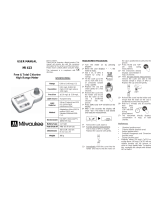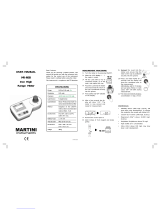
Dear Customer,
Thank you for choosing a Milwaukee Instruments
product. This manual will provide you with the necessary
information for the correct use of the instrument. Please
read it carefully before using the meter.
SPECIFICATIONS
Range 0.00 to 3.00 mg/L (NH3 - N)
Resolution 0.01 mg/L
Precision ±0.09 mg/L @1.50 mg/L
Light Source Blue LED 466 nm
Light Detector Silicon Photocell and 466 nm narrow
band interference filter
Method Adaptation of Nessler method
Environment 0 to 50 °C (32 to 122 °F)
100% RH max
Battery Type 9 volt (1 pc)
Auto-Shut o After 10’ of non-use
Dimensions 192 x 104 x 52 mm
(7.5 x 4.1 x 2”)
Weight 380 g
MEASUREMENT PROCEDURE
1. Turn the meter on by pressing ON/OFF.
2. When the LCD displays “- - -”, the
meter is ready.
3. Fill the cuvet with 10 mL of sample, up
to the mark, and replace the cap.
4. Place the cuvet into the holder and
ensure that the notch on the cap is
positioned securely into the groove.
5. Press ZERO and “SIP” will blink on the
display.
6. After a few seconds the display will
show “-0.0-”. The meter is now zeroed
and ready for measurement.
7. Remove the cuvet. Open it.
▶
8. Add 4 drops of NH3-1 (10 drops in case of seawater
analysis) and swirl gently.
9. Add 4 drops of NH3-2 (10 drops in case of seawater
analysis). Replace the cap and swirl gently.
▶ 10 mL ▶
NH3 1NH3 2
x 4 x 4
+
10. Immediately reinsert the cuvet into
the holder and ensure that the notch
on the cap is positioned securely into
the groove.
11. Press and hold READ for 3 seconds
and the display will show the
countdown prior to the measurement.
Alternatively, wait for 3 minutes and
30 seconds and just press READ. In
both cases “SIP” will blink during
measurement.
12. The instrument directly displays the concentration in
mg/L of ammonia nitrogen (NH3-N).
13. To convert the reading to mg/L of ammonia (NH3),
multiply by a factor of 1.216.
Interferences
yChloramines, various aliphatic and aromatic
amines, glycine, (positive error). To eliminate these
interferences distillation is required.
yAldehydes, alcohols (e.g. ethanol) or acetone (negative
error). To eliminate these interferences distillation is
required.
ySulfide (S2-): may cause turbidity.
yHardness above 1 g/L as Calcium Carbonate (CaCO3).
GUIDE TO DISPLAY CODES
This prompt appears for 1 second
each time the instrument is turned
on.
The dashes “- - -” indicates that the
meter is in a ready state and zeroing
can be performed.
Sampling In Progress. Flashing “SIP”
prompt appears each time the meter
is performing a measurement.
“-0.0-”, the meter is in a zeroed state
and measurement can be performed.
The blinking “BAT” indicates that the
battery voltage is getting low and the
battery needs to be replaced.
“-bA-”, the battery is dead and must
be replaced. Once this indication
is displayed, the meter will lock up.
Change the battery and restart the
meter.
“Conf”, the meter has lost its
configuration. Contact your dealer
or the nearest Milwaukee Customer
Service Center.
ERROR MESSAGES
On zero reading
yBlinking “-0.0-” indicates that the
zeroing procedure failed due to a
low signal-to-noise ratio. In this
case press ZERO again.
y“no L”, the instrument can not
adjust the light level. Please check
that the sample does not contain
any debris.
y“L Lo”, there is not enough light to
perform a measurement. Please
check the preparation of the zero
cuvet.
y“L Hi”, there is too much light to
perform a measurement. Please
check the preparation of the zero
cuvet.
On sample reading
y“-SA-”, there is too much light for
the sample measurement. Please
check if the right sample cuvet is
inserted.
y“Inv”, the sample and the zero
cuvet are inverted.
10 ml
▶



